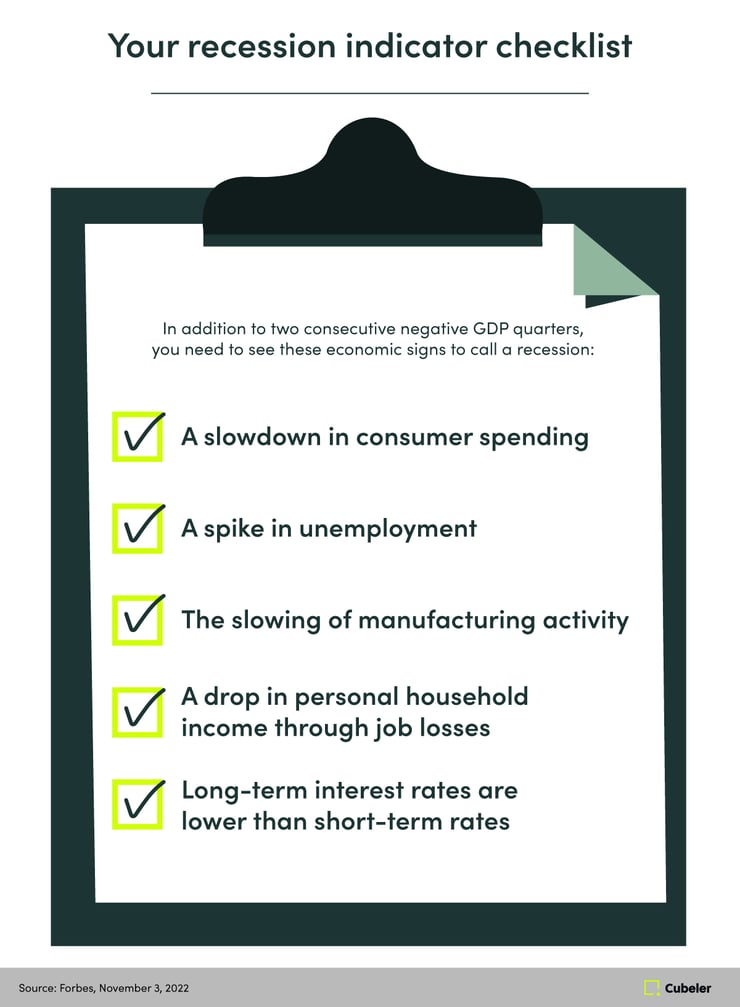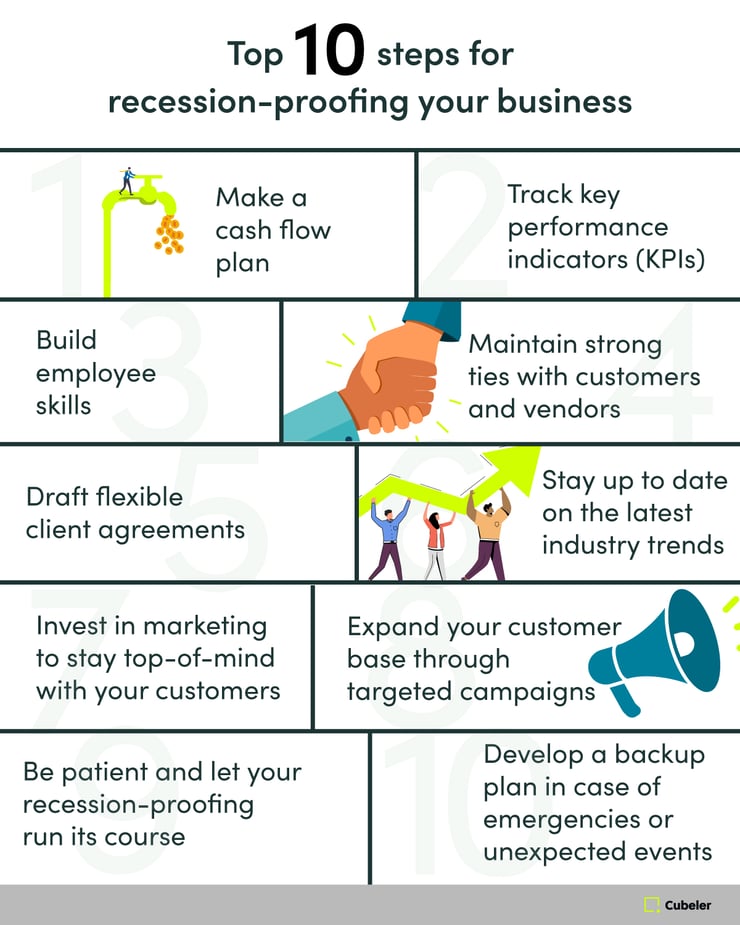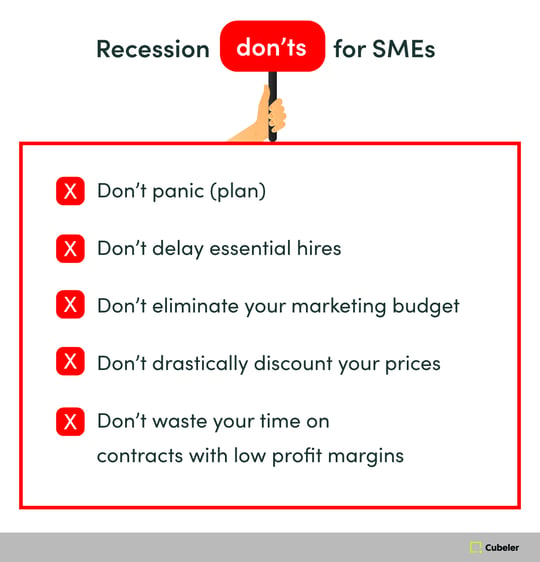Unlock the Power of Marketing: Get Your Free Marketing Plan Workbook
Enhance your marketing expertise with our free Marketing Plan Workbook, tailored specifically for small business owners...

Economists are saying a recession is imminent in 2023. If you haven’t already prepared for the worst, find out what you can do now to recession-proof your business and survive—even thrive—through the toughest of economic times.
Many economists are predicting Canada will enter a recession in 2023. Whether one happens or not, tough economic times are, by all accounts, imminent.
It’s crucial for SME owners and managers to recession-proof their businesses to not only ride out but sail through the economic storm ahead.
You’ll know the economy is in recession when…
Economists believe that rising interest rates, inflation and a slowdown in the U.S. economy may put the brakes on Canada’s economic growth in 2023. In a recession, the economy has two consecutive quarters of negative GDP growth, along with other economic signs. According to experts like Deloitte Canada, we’re about to enter into a recession that will be deeper than the pundits ever expected.

Why you need to recession-proof your business
Your business is your livelihood. It's your passion and your primary source of income. You want to make sure that a recession doesn’t lead to cost-cutting that eventually cuts off your ability to make a living.
Consumers tend to cut back on non-essentials or look for cheaper alternatives to products and services, and this impacts SMEs more than it does larger companies.
Losing sales and revenue typically forces SMEs to go over your credit limits, deplete cash flow, lay off employees, reduce services, narrow their product line—or all of the above.
It’s not all doom and gloom. By taking steps to prepare for an economic downturn, you can better weather the storm and keep your business afloat, even grow it, during a recession.
Key recession-proofing steps for your business
There are many ways to recession-proof your business. Before you do anything, you need to look at your business through the lens of your customers and employees.
When it comes to your customers, try to appeal to a wider audience by diversifying what you offer and pivoting toward products and/or services better suited to the current economy. Coupled with a stronger focus on customer service, this pivot can help build a more resilient business model that's better equipped to handle future challenges. For example, many restaurants during the pandemic set up contactless purchases and turned to selling meal kits that customers cooked at home.
From an employee standpoint, cutting expenses strategically and building your cash reserves can ensure you’ll have the resources to keep the people you need. This way, you’ll not only meet the needs of a wider customer base—you’ll also sail through the economic headwinds ahead. And just like every personal financial planner tells their clients, it makes sense to build an emergency fund to cover any unexpected expenses.

How to recession-proof your business in 10 steps
Here are 10 steps you can take to recession-proof your business:
1. Make a cash flow plan
SME owners are more affected by market downturns than big players. Get a handle on cash balances, monthly revenue and expenditures to ensure you have the cash flow to pay down bank overdrafts or loans, and avoid all the problems that come with non-sufficient funds.
2. Track key performance indicators (KPIs)
Closely tracking KPIs can keep you focused during a recession and help you adjust your sales, service, inventory and production to compensate for any market dips. Here are the KPI you should track:
Financial performance metrics like burn-rate, operating ratio, cash flow, credit limits and financing costs
Customer satisfaction and growth rate
Revenue growth
Employee satisfaction
3. Build employee skills
Your employees can help your business succeed and remain flexible. Build employee skills by cross-training staff and offering in-house training or times during their day to take online training. This can make employees feel connected to your business and more willing to go that extra mile for you.
4. Maintain strong ties with customers and vendors
Staying close to your suppliers makes sense, come rain or shine. But understanding the challenges they face and recognizing their needs can help you spot new revenue, product and service opportunities.
5. Draft flexible client agreements
As an SME manager or owner, you can build a loyal customer base by drafting flexible client agreements. You’ll be supporting each other through the worst of times, which should build their trust and respect. Consider small rewards for signing extended contracts, customizing what you offer your customers or offering more flexible payment terms.

6. Stay up to date on the latest industry trends
Keeping close tabs on your customers and competition is one of the best ways to stay up to date on the latest industry trends and gain a competitive edge. Make reading news about your industry a habit. Pick up the phone and speak to a vendor, client or competitor. Find out what’s happening in the market. Networking has never been more necessary.
7. Invest in marketing to stay top-of-mind with your customers
Now’s not the time to skimp on marketing. Whether your customers are consumers or other businesses, demand for your products and services will change. Consumers will become price-sensitive and businesses will look to cut costs. So, SMEs will need to change their advertising and marketing plans to reflect what’s going on.
8. Expand your customer base through targeted campaigns
Growing your customer base during a recession is possible if you target your marketing efforts. Are you up to speed with when, where and how your customers (your target audiences) make purchases, spend their time, work and read? This is the perfect time to update what you know about them. Along the way, research potential conferences and attend the ones that your customers attend.
9. Be patient and let your recession-proofing run its course
Being patient is easier said than done. But SMEs, especially family-run businesses, are adept at getting through tough times. Weathering a storm can come down to the intergenerational wisdom and experience on tap at SMEs. Having a personal stake and long-term commitment to the business can mean more level-headed management. So can the absence of external stakeholder pressure.
10. Develop a backup plan in case of emergencies or unexpected events
Building a backup plan before you need one can also save the day. It’s smart to work out a few scenarios and come up with an action plan for each case. This will help you avoid potential errors made under stress and bad decisions made on the fly. Asking frontline employees to brainstorm with you can also increase their “buy-in” when and if you decide to go ahead with your plan.
Ways to invest in your business during a recession
It’s understandable that you might be hesitant to spend money on growing your business, opening new markets or even making an acquisition in this economic climate. But downturns can be the right time to invest in your company. Instead of hoping the situation improves, position your business for growth.
If you have older equipment or your production line is in cramped quarters, it may be the time to invest in better tools and machinery, or upgrade to a larger warehouse or production facility.
In a recession, you’ll have the upper hand to negotiate better terms with your vendors, who may be looking for a way to close sales in a climate where many prospective clients prefer to keep their pocket money.
How to grow your business in a recession
Take a close look at your balance sheet to make sure your finances are in order. You’ll be in a better place to judge if you’re in survival or growth mode. This includes reviewing financing agreements to see if there’s room for negotiation and repayment flexibility. Remember, you’re a customer as well.
Improve your operational efficiency by cutting waste and freeing up capital. Things like overstock, defective products and poorly trained employees can work against you. You should solve these problems before you launch a full-scale growth campaign. This may mean investing in training, software upgrades and production process improvements.
This may also be the ideal time to get expert advice from a trusted advisor. They can help you spot the weak points of your business and identify ways to overcome them. Then, when your financial house is in order, look at whether exploring new markets makes sense for you.
Another resource you can trust are your long-term employees who understand your business from the ground up. Training them to enhance their skills can be more cost-effective than recruiting new talent, especially if you have to outsource the hiring process or do it all yourself. As the saying goes, a bird in hand is worth more than two in the bush.
Building a financial cushion will help you sleep at night
Having a financial cushion to support your growth, business investment or simply ride out the storm will ensure you have the means to achieve your goal. Here’s how to reduce your outgoing cash and raise capital.
How to reduce outgoing cash in a recession
Review and trim recurring expenses that won’t hurt your business.
Negotiate a more favourable rent, look for another location or downsize if it makes sense.
Negotiate better rates from vendors or search for new ones.
Put off unnecessary expensive purchases that would affect your bottom line.
How to raise more capital in a recession
Sell unused assets. It’s time to get rid of that backup equipment you’re holding on to ‘just in case.’
Raise funds from relatives or investors. A former employer, as well as other industry stakeholders, like a retired business owner, could become a silent partner.
Close long-term deals at a considerable discount. This gives you access to cash that, if necessary, you’ll need to keep the lights on and pay staff.

Quick takeaways
Recession-proofing your small or medium-sized business is not only important for protecting your income and livelihood, but it's also a smart way to build a stronger, more resilient business for the long haul.
Economists are calling for a recession in 2023. Many economic signs need to be there to call a recession, particularly if the economy has two consecutive quarters of negative GDP growth.
By taking the time to prepare for tough times, you'll be better positioned to weather any economic storm that comes your way.
Get a handle on your cash balances, monthly revenue and expenditures to ensure you have the cash flow to pay down bank overdrafts and loans—and avoid getting caught off-guard with non-sufficient funds.
Be prepared for B2C and B2B sales and revenue to dip in response to an economic downtown. During a recession, consumers usually cut back their spending and look for product or service alternatives. At the same time, businesses try to renegotiate long-term contracts at more favourable terms.
Diversify your products and/or services, so what you sell can appeal to a wider range of customers and potentially offset any declines in sales.
Focus on customer service and build vendor relationships, so you can recognize when their needs change and be proactive in your response.
Now’s not the time to skimp on marketing, but you’ll need to target your campaigns to meet the new needs of your B2C and B2B clients.

Enhance your marketing expertise with our free Marketing Plan Workbook, tailored specifically for small business owners...

Find out what you need to know to bypass the most common marketing pitfalls.

Expand your SME business network the right way. Learn how to connect with like-minded SME owners and decision-makers to...